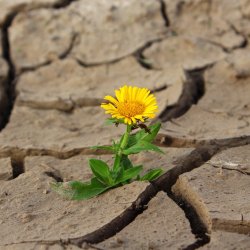El Nino provided some relief to California’s water woes this year, as reservoirs filled near their tops. According to the USDA Drought Monitor, however, 74% of the state remains in a severe to exceptional level drought. It’s official: our state’s historic drought continues. How can we respond as responsible citizens to maintain a healthy community?
In California, energy and water are inextricable interrelated. Drought conditions result in less rainfall, less mountain snowpack, and earlier snowmelt, making less water is available for hydroelectricity generation. And about 20% of California’s energy usage is used in water management- treating, pumping, and transporting water throughout the state. And during drought years, when surface and groundwater levels drop, even more energy is required to pump each gallon of water. Our efforts to address drought through water conservation, then, has a compounded impact on California's consumption energy.
Save Water, Reduce Greenhouse Gas Emissions
Water conservation is helpful in dealing with water scarcity, but it is also key in reducing the use of polluting energy technologies like fossil fuels and natural gas. Saving water also means saving energy, which is a big part of California’s plan to reduce greenhouse gas emissions and address climate change.
Now’s the Time to Save at Home
This summer’s predicted high temperatures and dry weather translate into more time running air conditioners and sprinklers. This puts increases the strain on both our energy and water systems. But after five years of drought, water conservation is becoming a way of life for many Californians. Californians met the state's water reduction targets last year, curbing 25% of urban water consumption. There are a many simple tips to reduce demand on water and energy used to heat it.
- Opt for shorter showers over baths
- Wait to run clothes and dish washers until loads are full
- Set programmable thermostat to around 78 degrees when home and 85 degrees when out
- Keep your refrigerator and freezer full; they use more energy to stay cold
- Put your wet clothes out to dry on a drying line or rack
- Use cold water for full loads of laundry
- Eliminate leaky faucets or toilets, save around 3,000 gallons a year
- Turn the temperature down on your hot water heater and insulate hot water pipes
- Address air gaps in your home by repairing with caulk, spray foam or batting (see diagram below)

EnergyUpgradeCA.org has wealth of information for homeowners and businesses to adopt conservation strategies that fit their needs and their pocketbooks. Check out Energy Upgrade California and Save our Water to for more information on energy and water efficiency, and help keep California Golden!
Kari Kapadia is Data Analyst for GRID Alternatives North Valley, a nonprofit organization making renewable energy technology and job training accessible to low-income communities. GRID Alternatives North Valley is a second year community ambassador for Energy Upgrade California, a state initiative to help Californians take action to save energy and conserve natural resources.
Follow Energy Upgrade California:
Website: EnergyUpgradeCA.org
Twitter: @EnergyUpgradeCA
Facebook: Facebook.com/EnergyUpgradeCalifornia
Follow the Save Our Water Campaign:
Website: SaveOurWater.com
Twitter: @SaveOurWater
Facebook: Facebook.com/SaveOurWaterCA

